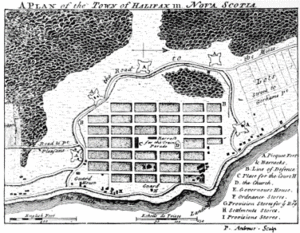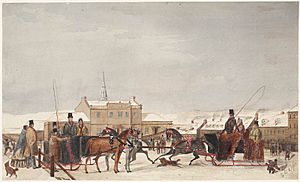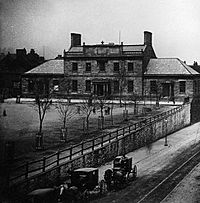Grand Parade (Halifax, Nova Scotia) facts for kids
Quick facts for kids Grand Parade |
|
|---|---|
| Public square | |
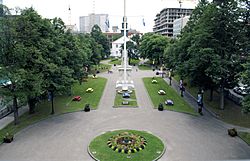 Grand Parade from City Hall |
|
| Features: | Cenotaph, flagpole |
| Opening date: | 1749 |
| Area: | 0.6 hectares (1.5 acres) (approx) |
| Surface: | Grass, brick |
| Location: | Halifax, Nova Scotia |
The Grand Parade is a special historic public square in Halifax, Nova Scotia. It has been around since Halifax was founded in 1749. At the north end of the Grand Parade, you'll find the Halifax City Hall, which is where the local government meets. At the south end is St. Paul's Church, a very old building. Right in the middle of the Grand Parade stands the cenotaph, a monument built to remember soldiers who served in World War I.
This square is located in Downtown Halifax and is a very important place for the city. Many events happen here, like music shows, public gatherings, New Year's Eve parties, Remembrance Day ceremonies, and the lighting of the Christmas tree.
Contents
History of Grand Parade
How Grand Parade Began (18th Century)
The first British settlers arrived in Halifax in June 1749. By October of that year, they had built 300 houses. A military engineer named John Brewse chose the town's location for defense. Charles Morris, the Chief Surveyor, planned the town's layout. A settler named Moses Harris published the town map in 1749. This map showed a grid of streets with the Grand Parade right in the middle. The plan suggested a church at one end and a courthouse at the other, but the north end stayed empty for a while.
Governor Cornwallis ordered wood from Boston to build a church soon after arriving. The first stone for the church was laid on June 13, 1750. It was named St. Paul's in 1759. The building was designed like Marybone Chapel in London.
In 1794, Prince Edward came to Halifax to lead the military. He worked to improve military buildings and had the Grand Parade leveled to make it more useful. Because Barrington Street slopes down, a retaining wall was built to keep the square flat. This wall was tall enough to create space underneath, which was first used as ice houses.
Changes in the 19th Century
The first building for Dalhousie College (now Dalhousie University) opened at the north end of the Grand Parade in 1821. It was a four-story building with a Georgian style. Over time, the Grand Parade started to look run down. Dalhousie College said they didn't have money to fix it, and the city wasn't sure who owned the square. Meanwhile, the city's offices were in a very old and "dirty" building.
In 1872, the city council asked E.H. Keating, the city engineer, to find ways to improve the Grand Parade. Keating suggested building a new city hall at the south end. However, people preferred the Dalhousie College site at the north end. Eventually, Dalhousie College agreed to move to the city's South End. A decision was made to build a "respectable building" where the college used to be. At this time, Mayor James MacIntosh suggested renaming the square after Queen Victoria, but this idea was not used.
A grand new building was designed by Edward Elliot. The old college building was torn down in 1886. The first stone for the new city hall was laid in 1888. After the city hall was finished, Keating completely redesigned the square. He added a circular driveway that started at Barrington Street and looped in front of City Hall. The retaining wall on Barrington Street was also rebuilt.
Grand Parade in the 20th Century
Keating's plan included a circular fountain, but it wasn't built until 1905. This fountain was later removed to make space for the Cenotaph. The Cenotaph was officially revealed on July 1, 1929, by Sir Robert Borden. It was designed by Scottish sculptor J. Massey Rhind to honor Canada's soldiers who died in war.
In 1907, the retaining wall on Barrington Street was made bigger to include a stable. There were also plans for public toilets, but these were not built. Later, this space became a police station until 1952. Today, this area is closed off and not used.
A new flagpole was put up for the city's 200th birthday celebration in 1949. This huge, 128-foot-long log came all the way from British Columbia. It was brought by train to the Bay of Fundy, then by boat to Digby. From there, it was loaded onto three train cars and arrived in Halifax on August 4, 1947. The new flagpole was put up by the Royal Canadian Engineers and officially revealed in September 1947.
There used to be a short street called St. Paul's Hill in front of St. Paul's Church. It connected Barrington and Argyle Streets. This street was created after Prince Edward's visit in 1794. The church's address was 1 St. Paul's Hill. A bus even used this street in the 20th century. However, it was closed between 1977 and 1978, and the land became part of the Grand Parade.
The square was improved in 1995 for the 21st G7 summit, a meeting of world leaders. Three main areas were created: St. Paul's Plaza, the Civic Plaza in the center, and the City Hall Plaza. A new entrance to the City Hall Plaza from Argyle Street was added in 1999.
Recent Changes
For many years, city council members were allowed to park their cars in the Grand Parade. This was a debated topic, with many people wanting the parking removed so the space could be used by the public. After several discussions and votes, the council finally decided to move the parking lot from the Grand Parade starting September 1, 2007.
On October 17, 2010, a concrete arch was revealed. This arch is a memorial to peace officers who died while on duty. It has the names of 21 fallen Nova Scotia peace officers carved into it.
Events and Gatherings
The Grand Parade hosts many events throughout the year. Every November 11, the Cenotaph is the site of the official Remembrance Day ceremony. There are also celebrations for other holidays like Canada Day and an annual concert and countdown for New Year's Eve. Community groups can also use the square for special events. However, there are rules, like not allowing too much advertising and keeping events at least 20 feet away from the Cenotaph.
Important visitors, like members of the royal family, often visit the square to meet the public. For example, the Queen visited in 1994 during a tour of Canada. She reviewed a guard of honor and placed a wreath at the cenotaph.
The Grand Parade is also a popular place for political demonstrations and as a starting or ending point for protest marches.
Occupy Nova Scotia
An "Occupy Nova Scotia" camp was set up at the Grand Parade on October 15, 2011. About 300 people gathered with around 25 tents, including a medical tent, an art tent, and a food and entertainment tent. They held discussion groups and art activities. The camp grew to 30 tents by October 20, even after a heavy rainstorm.
Key Features of Grand Parade
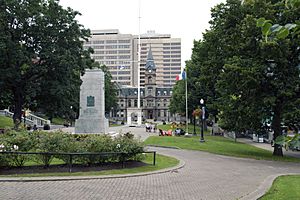
Halifax City Hall
The Halifax City Hall stands where Dalhousie University's first building was located in 1821. The university building was taken down to make way for the new city hall. Some of the wood from the old college was even used in the new municipal building.
Architect Edward Elliot designed City Hall, and it was built between 1887 and 1890. It is one of the oldest and largest public buildings in Nova Scotia. It is also a National Historic Site of Canada. The building is made of cream and red sandstone and has a grand, mixed style. The ground floor and the tower are made of granite. The seven-story tower has clocks on its north and south sides. The clock face on the northern side is stopped at four minutes past nine to remember the Halifax Explosion of 1917.
The Cenotaph Monument
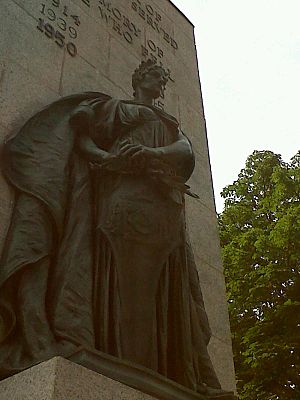
The Cenotaph in the middle of Grand Parade was officially dedicated on Dominion Day (July 1) in 1929. Former Prime Minister Robert Borden dedicated it to remember those who died in World War I. The bronze parts of the cenotaph were inspired by Edwin Lutyens' famous Cenotaph in Whitehall, England. It features a statue of Britannia by the well-known Scottish sculptor John Massey Rhind. The Cenotaph is made from local Tangier granite.
The sculpture shows a victorious but sad Britannia, representing Nova Scotian mothers. It also has three ceremonial wreaths, names of battles from the First and Second World Wars, a dedication, and the coats of arms of both Nova Scotia and Canada. There is also a Victory Cross.
During a check-up in 2009, some problems were found with the monument's structure. It was completely taken apart and rebuilt in time for the Remembrance Day ceremony that year.
St. Paul's Church
St. Paul's Church is the first Protestant church built in Canada and the oldest building in Halifax. It was founded in 1749, and the first service was held on September 2, 1750. It is the oldest Anglican church in Canada that is still standing. Its design is based on the church of St. Peter's, Vere Street in London, with later additions like a larger tower. For many years, it was one of the only places of worship in Halifax, so other religious groups also held services there.
During the Halifax Explosion of 1917, a piece of wooden window frame from another building was blasted into the wall of St. Paul's Church. It is still there today.


